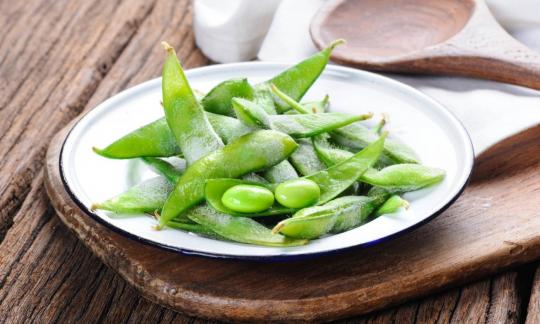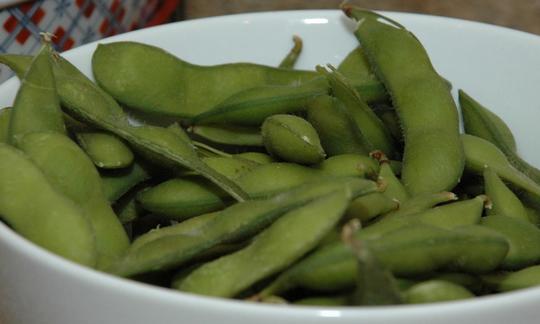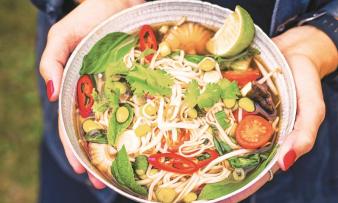Table of contents
Edamame , originally from Asia, are soybeans ( Glycine max (L.) Merr.) that have been harvested unripe and can also be bought frozen in Europe. Traditionally, they are served boiled and salted as a snack. They are also available in organic quality.
Use in the kitchen
How to prepare frozen edamame? How to blanch frozen edamame? Green soybeans from the freezer are quick and easy to prepare, as they are usually sold pre-cooked or at least blanched. The frozen, occasionally shelled beans are placed in boiling, lightly salted water.
How long do you cook edamame? Previously blanched and frozen beans are removed from the water after about 3-5 minutes - or according to the instructions on the packet - (reduced cooking time). Then they are sprinkled with salt or soy sauce and spices such as chili or garlic . Fresh edamame , on the other hand, are cooked with the pods for about 5-7 minutes and served as a vegan starter, for example.
How do you eat edamame? You don't eat the pod itself because it is tough and full of fiber. After cooking, you press the soft beans out of the pod with your fingers or nibble them out with your teeth. Each pod usually contains three green, oval beans that have an intensely nutty and sweet taste.
The beans without the shell are an ideal splash of color in mixed vegetables, vegan curries and vegetable rice. However, if cooked for a long time, edamame lose their beautiful green color. Cooked edamame are also excellent as an ingredient in miso soup or for homemade hummus . Green soybeans also taste good with tofu, roasted peanuts or combined with pasta. In Japan, the whole beans are a popular snack, for example with beer.
Homemade
How can you freeze fresh edamame yourself? You can freeze green soybeans raw, but this is not recommended due to the loss of flavor and texture. Better: Blanch fresh beans and then immediately freeze them after cooling them in ice water. This way, the protein-rich edamame beans will last a long time and will not lose their flavor and vitamins so quickly.
Vegan recipe for edamame salad
Ingredients: 400 g edamame (frozen, organic), 200 g cucumber , 2 spring onions , 5 radishes , 15 g fresh coriander leaves , 50 g rocket , 1 tbsp sesame seeds. For the dressing: 10 g ginger , 1 garlic clove , ½ chili pepper , 2 tsp sesame oil (roasted ), 2 tbsp soy sauce , 1 tsp agave syrup, 2 tbsp lemon juice , 2 tbsp rice vinegar .
Preparation: First prepare the frozen edamame: To do this, boil them in salted water for about 3-5 minutes, drain in a sieve and rinse with cold water. If necessary, remove the seeds from the pods. Halve the cucumber lengthways, remove the seeds if necessary and cut into thin, long strips. Cut the spring onions and radishes into rings, finely chop the coriander. Mix the edamame, cucumber, onions, coriander and rocket together. If necessary, briefly roast the sesame seeds in a coated pan without oil (but it is healthier unheated). For the dressing, peel the ginger and garlic and grate very finely. Chop the chili pepper. Mix all the ingredients of the dressing together and pour over the salad. Mix well and let the vegan dish sit for about 10 minutes.
Vegan edamame recipes can be found under the note: " Recipes that have the most of this ingredient ".
| Not only vegans or vegetarians should read this: Vegans often eat unhealthily. Avoidable nutritional mistakes . |
Purchasing - Storage
Edamame is available in Europe mainly in Asian shops or online - with or without pods, depending on the product. In addition to frozen soybeans available all year round, you can also buy canned and, rarely, fresh beans.
Swiss farmers occasionally grow edamame in organic quality and sell it locally from the farm (as of February 2022). The beans are available fresh in season and frozen out of season. 2 Frozen organic edamame from Switzerland in Demeter quality has also been available at Alnatura since 2016. Supermarkets such as Migros , Coop , Denner , Volg , Spar , Aldi , Lidl , Rewe , Edeka , Hofer , Billa etc. always stock frozen or canned goods, some even in organic quality. New on the market are noodles that are made from 100% edamame.
The availability of frozen edamame varies depending on the size of the store, catchment area, etc. Our recorded food prices for the DA-CH countries can be found above under the ingredient image - and by clicking you can see their development at various suppliers.
Storage tips
Fresh edamame will keep for a few days in the fridge, frozen beans can be kept in the freezer for up to 12 months. If you don't want to accept any loss of sugar content, use them after about 6 months. 20
Ingredients - Nutritional values - Calories
Frozen edamame is likely to have been blanched using steam before freezing for sale. 20 These edamame beans are characterized by a high protein content (11%) and are rich in vitamins, minerals, trace elements and fiber (approx. 5%). The energy content is 109 kcal/100g. 3
The high folate content is particularly noteworthy. At 303 µg, 100 g cover more than the daily requirement. Yeast flakes have a similarly high value at 300 µg/100g, but you consume much less of it. Borlotti beans (raw: 604 µg/100g) and chickpeas (raw: 557 µg/100g) contain even more folic acid. In cooked chickpeas, the value is reduced to around 63 µg/100g. Folate is important for cell growth, protein metabolism and, above all, for the development of the fetus. During pregnancy and breastfeeding, the need for folic acid is significantly higher, even before pregnancy. According to the Federal Institute for Risk Assessment ( BfR ), adults need 300 µg, pregnant women 550 and breastfeeding women 450 µg daily. 4
Depending on the duration and temperature 21 , blanching can lead to a change in the sensory and nutritional properties. Some minerals and water-soluble vitamins (including B vitamins and vitamin C) are lost. Fat-soluble components (e.g. β-carotene), fiber and poorly soluble minerals are retained. 8 Phenolic antioxidants and heat-sensitive vitamins are also affected - a study showed that blanching many types of vegetables can result in the following losses: antioxidant activity (up to 30%), about a third of the vitamin C and more than half of the folic acid. 8
Since edamame has to be heated to be enjoyed anyway, certain losses cannot be avoided.
The complete ingredients of frozen edamame, the coverage of the daily requirement and comparison values with other ingredients can be found in our nutrient tables. In the article Nutrients explained you will get a detailed insight into the topic.
Health effects
Are edamame healthy? Beans in general have a diuretic, antimicrobial and cancer-preventing effect. With their content of secondary plant substances (saponins, flavonoids) they lower cholesterol and blood sugar. 5
The slowly rising blood sugar level is due to the fiber contained in pulses. This is why diabetics are also advised to eat them regularly. 6
Studies postulate that daily intake of >20 g of soy protein can lower serum levels of LDL cholesterol and triglycerides as well as total cholesterol. In some cases, an increase in the beneficial HDL cholesterol and a decrease in blood pressure could be observed. The positive effects on the risk profile of cardiovascular disease are primarily attributed to the soy protein. The administration of isoflavone preparations, however, is controversial. 22
Dangers - Intolerances - Side effects
Can you eat edamame raw? No, they are not suitable as raw food. Legumes such as soybeans , which include edamame, are very rich in nutrients, but they also contain anti-nutritional substances such as lectins (toxic proteins) or alkaloids, which are poisonous in large quantities. Therefore, fresh, dried and frozen edamame should be cooked before consumption and not eaten raw. 5,8
Many scientists are still divided on the positive effects of isoflavones. Isoflavones are phytoestrogens that are similar to the body's own estrogen. This phytohormone can activate and block estrogen receptors in the body, even if its effect is 100 to 1000 times less than that of the body's own estrogen. However, a diet rich in soy plus nutritional supplements containing phytoestrogens can exceed the body's own production many times over. 9 The Federal Institute for Risk Assessment ( BfR ) advises women in and after menopause in particular against long-term consumption of foods containing isoflavones. Women suffering from breast cancer or those at increased risk should also not take phytoestrogens. However, the consumption of foods containing isoflavones is permitted without any concerns. 9
People with thyroid disorders should pay particular attention to ensuring they have an adequate supply of iodine when eating a diet rich in soy. There is no risk for healthy adults from soy products containing isoflavones. 10
The Nutrition Commission of the German Society for Pediatric and Adolescent Medicine advises against the consumption of soy products in infants. Soy protein isolates have come under criticism because of their aluminum, phytate and phytoestrogen content. Negative effects of isoflavones on the reproductive organs, the immune system and the thyroid gland cannot be ruled out in infants. The administration of soy products to children under 12 months should always be discussed with a doctor. 11
For more detailed information about these studies, see the ingredient Edamame, raw .
Ecological footprint - animal welfare
As unripe soybeans, edamame most likely have a similar, albeit lower, carbon footprint than ripe soybeans. However, this depends heavily on the area in which they are grown. Soy cultivation leads to the deforestation of large parts of the rainforest, particularly in Brazil, the largest producer of soy, but also in Paraguay and Bolivia. This worsens the ecological footprint of soy from these countries of origin: When land is changed from rainforests to arable land, especially in the case of large-scale slash-and-burn practices, the carbon stored in the trees is released and enters the atmosphere in the form of CO2 . 18
To produce 1 kg of soya, 2145 litres of water are needed, which is similar to the amount needed to produce rapeseed (2271 litres) and slightly less than for peanuts (2782 litres). 19
Legumes such as soy, peas or lentils bind important nitrogen in their root nodules, which is also available to other plants in the soil after harvest and naturally increases soil fertility. Accordingly, they are suitable plants for crop rotation in organic farming. In addition, the integration of legumes in crop rotation can help to break the life cycle of certain pathogens, make important nutrients available and improve soil structure. 1 In addition, soy blooms in midsummer, when there is hardly any nectar available for bees, bumblebees and other insects. Although the nectar supply for soy is rather low and the flowers are small, the soy plants make at least a small contribution to the nectar supply. The nectar is the food of the bees, i.e. pollen, nectar and honeydew. Trials on the effect of pollinators on increasing yields of rapeseed, fruit and soy are still ongoing in Brazil and the USA. However, these are late-ripening soy varieties with significantly larger flowers. 16
The massive use of pesticides in soy cultivation is also ecologically questionable. In Brazil, genetically modified soy is mainly grown. The modified plants are resistant to certain herbicides that are used liberally to control weeds. Even if this method is quick and easy to use, the negative effects on soil fertility and biodiversity should not be underestimated.
When shopping, it is best to look for regional, organically grown edamame beans. No synthetic pesticides or fertilizers are used and the beans have not been transported over long distances.
Worldwide occurrence - cultivation
The soybean Glycine max is derived from the wild form Glycine soja , which was used in 7000 BC in northern China and 5000 BC in Japan. Larger, cultivated soybeans were known in 3050 BC in Japan and 1550 BC in Korea. They have been used in China since around 550 BC, where they were one of the most important food plants alongside millet. 12
The term edamame can be dated back to around 1275. 14 The soybean reached Europe around 1691/92 through Engelbert Kaempfer 17 and the USA around 1765 through Samuel Bowen 13 . In 1980, edamame became known in Europe through the "sushi boom". 14
By 2023, the United States and South America will be the world leaders in soybean cultivation.
Cultivation - Harvest
There are now varieties of edamame that are suitable for the Central European climate. Apart from that, these soybeans are harvested unripe. As soon as the night temperature does not fall below 10 to 12 °C, you can start sowing. To do this, place one bean every five centimeters in a three-centimeter deep furrow, cover it with soil and press it down well. There should be at least 40 centimeters between the rows. The plants reach a height of up to one meter. The beans for edamame can be harvested after about two months, and you should be able to see them under the pod. The fluffy hairs on the pod must still be light to beige-brown. Tip: If you sow at different times, you can harvest over a longer period. 15
Commercial cultivation of edamame takes place under conventional conditions in Asia. Large retailers import the frozen goods. 2 In Germany, Austria and Switzerland there are some farmers who cultivate edamame and sell it nationally, both fresh and frozen.
Further information
Edamame are soybeans harvested unripe ( Glycine max (L.) Merr.). The name comes from the Japanese term edamame (Japanese: 枝豆), which means "beans on the branch". Green soybean kernels without pods are also called edamame.
Soybeans belong to the subfamily Faboideae within the family Leguminosae or Fabaceae.
Are sugar snap peas edamame pods? Sugar snap peas, also known as snow peas, snap peas, mange-tout peas, are not beans but peas ( Pisum sativum subsp. sativum convar. axiphium ). You can find out why sugar snap peas, unlike edamame, can be eaten raw in our article Sugar snap peas (sweet pea), edible pod, raw .
Alternative names
Edamame is a plural word. In Japan they are often called lucky beans or stalk beans. In German they are also known as Japanese beans, green soybeans or Japanese stalk beans. Incorrect spellings (eg edamamen, edamames, edame) creep in.
The English name is edamame, edamames or edamame beans as well as (green) vegetable soybeans. Frozen edamame is called frozen edamame.











Comments